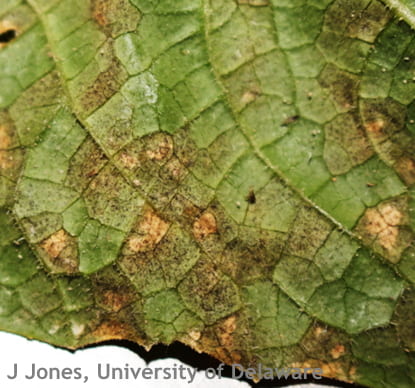Jake Jones, Extension Agriculture Agent, Kent County; jgjones@udel.edu
Cucurbit downy mildew was found in pickling cucumbers in Federalsburg, Maryland on Thursday, June 17, 2021. One day prior it was found in New Jersey in pickling cucumbers. With the disease now on the Delmarva Peninsula the annual epidemic has begun, almost three weeks earlier than in 2020. The disease thrives in cool, wet weather and the disease cycle can progress from initial infection to production of sporangia in as little as 5-7 days. Preventative fungicides should be applied to both resistant and non-resistant cucumber varieties to protect yield and are much more effective than curative sprays. Another reason curative sprays are not recommended is the risk of fungicide resistance developing. Rotating modes of action (FRAC Codes) and tank-mixing with a protectant fungicide is important for both short-term and long-term success in managing this disease. See Table 1 for a list of effective fungicides from the Mid-Atlantic Commercial Vegetable Production Recommendations. Orondis, Ranman, Zing!, and Bravo were some of the most efficacious fungicides in regional bioassays.
Symptoms of the disease in cucumber start as angular, water-soaked lesions on the underside of leaves and progress to chlorotic and necrotic angular lesions. Dark sporulation is a diagnostic sign of cucurbit downy mildew and can be seen with a hand lens or with your naked eye (Figure 1). Cucumbers are usually the first cucurbit crop infected with different clades of pathogen causing the disease in other cucurbit crops later in the season.
Table 1. Cucurbit Downy Mildew Fungicides, from the Mid-Atlantic Commercial Vegetable Production Recommendations.


Figure 1. Angular, sporulating lesion of cucurbit downy mildew in cucumber.
